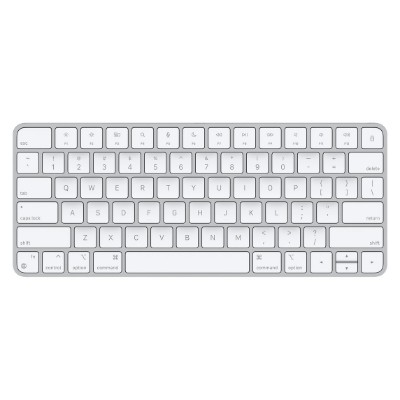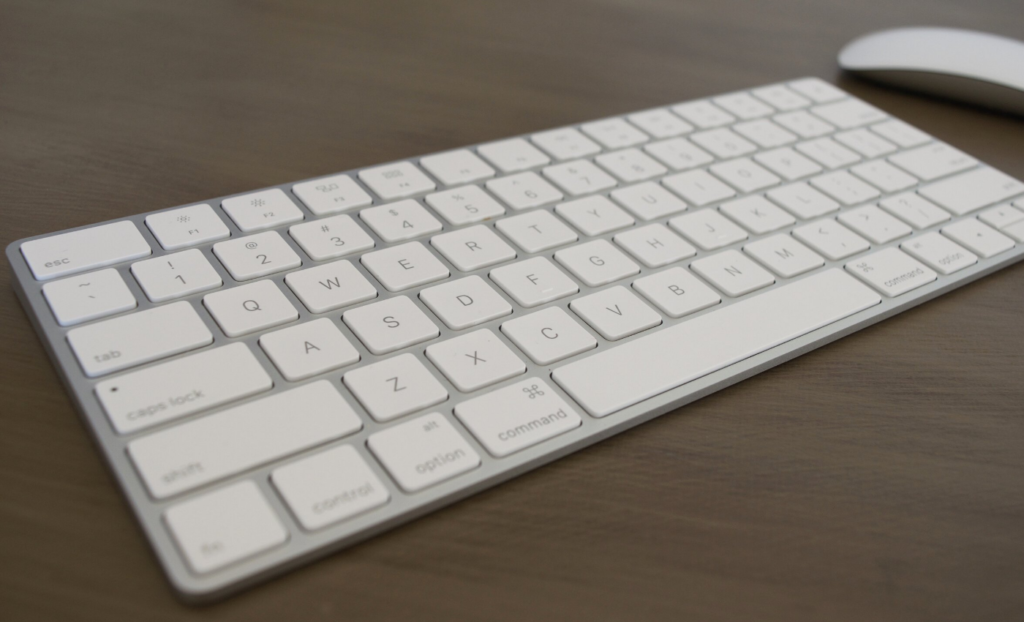Everyone views Apple a little differently. Some see the company as an innovator, with intuitive and exceptionally durable products worthy of their high price tags. Others refuse to indulge Apple’s insane markups, opting to spend half the price for products that do twice as much — even if they lack Apple’s refined sophistication.
The Apple Magic Keyboard fits this same narrative. It’s a finely-tuned machine, one that syncs beautifully with your other Apple devices and always provides a reliable typing experience. But it also comes at a $100 price and lacks commonplace features like adjustability and versatile OS support.
Is the Apple Magic Keyboard worth it? In this Apple Magic Keyboard review, we’ll go through the pros and cons, and look at the magic behind the keyboard. Join me as we uncover whether it’s a premium peripheral or just another overpriced gadget.
Apple Magic Keyboard Pros & Cons
- Lightweight yet durable aluminum chassis (~8 ounces) is ideal for travel
- Sleek white and silver design features Apple’s minimal aesthetic
- Media control hotkeys ensure quick access to common commands
- Eco-friendly, rechargeable battery lasts roughly a month on a single charge
- $100 price tag is expensive for a small membrane keyboard
- 30ms latency is too high for gaming and fast-paced environments
- Lacks ergonomic-oriented features like negative tilt or a wrist rest
- Only partially compatible with Windows and Linux machines; does not work on Android devices

- Price: $99
- Layout: TKL
- Connectivity: Wireless
- Switches: Membrane Scissor Switch
- Best for: Apple users
- Warranty: 1 Year
- Return Period: 14 Days
- Shipping: Free
- Connects to your Mac, iPad, and iPhone via Bluetooth
- Tenkeyless layout provides a compact, portable frame
- ABS-topped membrane scissor switches offer smooth, responsive typing
What Does the Apple Magic Keyboard Feel Like To Use?
The Apple Magic Keyboard is delightful, and I love how easy it is to start using it. The streamlined unboxing process includes three self-explanatory components: the keyboard, a USB cable, and a starter guide. You can read the guide if you please, or you can plug the keyboard into your Mac, flip the top-right switch, and voila! Like magic, the keyboard has synced with your machine, and you’re ready to start using it wirelessly.
Of course, this is a keyboard we’re talking about, and the real test is how well it types. Let’s deconstruct the talking points, beginning with comfort & ergonomics.
Comfort & Ergonomics

For starters, the Apple Magic Keyboard is a membrane keyboard with Apple scissor switches. Although I prefer mechanical keys, these scissor switches are surprisingly pleasant, actuating via a see-saw mechanism that snaps down with excellent spring. The keys require just over 60 grams of force to operate, which is a little on the heavier side. But it balances out with the short travel distance, providing a responsive keypress without all the misfires commonly found on low-profile keys.
Concerning ergonomic elements, the Apple Magic Keyboard measures 0.75″ by 5″ by 11.5″ and features a slight upward angle of about 3°. I love the slim, compact design, which takes up little space on your desk and ensures easy access to all the keys. Although I dislike the lack of a negative tilt attachment or integrated wrist rest, I’ve experienced minimal fatigue with the Magic Keyboard, even after typing all day. I’d say that it’s comfortable enough, but nothing to write home about.
Performance
You can use the Apple Magic Keyboard in either wired or wireless mode. Both offer dependable performance, though you’ll get a slightly quicker response time in wired mode. Unfortunately, even the ~30ms wired response time won’t cut in fast-paced environments (e.g., gaming). It’s best suited for the office, where it has no trouble keeping up with general business activities and even 100+ WPM typists.
Concerning connectivity, the Magic Keyboard’s Bluetooth chipset is quite stable on macOS and iOS, and you needn’t worry about missing keypresses or random disconnections. In my many months using a Magic Keyboard, I’ve never had to deal with any troubleshooting issues — a massive boon and something that only Apple could pull off so well. The battery life also lasts up to 30 days on a single charge, which is a user-friendly and eco-friendly design decision that I love.
Perhaps the biggest downside to the Apple Magic Keyboard is its lack of operating system compatibility. Sure, it performs flawlessly on macOS, with plenty of customizability via Apple’s keyboard center. But you won’t enjoy the same versatility on iOS. What’s worst, there’s no officially supported software on Windows or Linux devices, which many users prefer or must use over macOS. Apple only accounts for around 10% of desktop market share, making the Magic Keyboard near-worthless for a large percentage of the workforce.
Construction & Design
The Apple Magic Keyboard is the perfect complement to any Apple-themed office. It features the same white and silver design that’s become synonymous with Apple over the past several decades.
In terms of durability, the Magic Keyboard boasts a lightweight yet surprisingly robust aluminum chassis and ABS keycaps that can take quite the beating. It also comes with little rubber feet that remain steadfast while typing, yet hardly impact the overall weight or height.
Something I’d like to see on the next Magic Keyboard is a riser that lets you adjust tilt and angle. In particular, I’d like to see the ability to customize the downward tilt for better ergonomics. I understand Apple’s less-is-more intention, but lack of adaptability is an egregious omission on such an expensive work-oriented peripheral.
Our Verdict of the Apple Magic Keyboard

The Apple Magic Keyboard is a respectable option for macOS and iOS users. It connects via Bluetooth or USB cable and performs like a dream, offering the quality and reliability you’ve come to expect from Apple.
Set it on your desk to use at work, or bring it with you on business trips for quick work sessions in between clients or tasks. You won’t be disappointed by the lightweight yet robust aluminum chassis and ABS-topped scissor switches, which retain strength and provide an excellent, responsive experience.
Just know that its application is limited. While the Magic Keyboard performs plenty of fancy tricks on macOS, there’s little support for iOS. What’s more, there’s no software support whatsoever for Windows or Linux.
You’re also paying for the Apple logo. A quick Amazon search shows countless imitators that look and feel almost identical to the Magic Keyboard at half the price. They also tend to work better with other platforms (even Android) and offer more functionality out of the box. They may not have the same overall reliability, but not by much.
There’s no doubt that the Magic Keyboard complements your Mac, iPad, and iPhone better than most other options. It syncs up flawlessly and even looks the part, incorporating white keycaps with an underlying twinkle of silver that hints at its premium componentry and overall reliability. If you’re willing to pony up the cash, Apple will reward your loyalty with a peripheral that provides years of loyal service in return.
Other Models from Apple
- Magic Keyboard with Touch ID | Amazon ($149) – For those using Apple’s new M1 chip, the Magic Keyboard with Touch ID integrates a fingerprint sensor for easy access to your Apple accounts.
- Magic Keyboard with Numeric Keypad | Amazon ($129.00) – If you like the Magic Keyboard but need a number pad, the Magic Keyboard with Numeric Keypad is an excellent alternative.
Comparable Keyboards from Other Brands
- Logitech K380 | Amazon ($29.99) – The K380 features a similar size shape and design, but it supports all your devices (including Android) and integrates extra features like Logitech Flow.
- Keychron K2 | Amazon ($69) – If you prefer a classic, mechanical-style keyboard, the KeyChron K2 includes Gateron switches for linear or tactile typing.
- Microsoft Sculpt | Amazon ($80.95) – Whereas the Apple Magic Keyboard lacks ergonomic extras, Microsoft’s Sculpt provides a comfy-cozy experience with a giant wrist rest and negative tilt.
Should You Buy The Apple Magic Keyboard?
If you swear by Apple’s product ecosystem and enjoy its business-oriented products, you won’t be disappointed by the Magic Keyboard. It plays nicely with all your other Apple devices and offers the same intuitive experience you know and love.
However, I don’t recommend the Apple Magic Keyboard for casual or non-Apple users. The premium price tag is not worth its mediocre functionality (even if it is exceptionally reliable) or lack of ergonomics.
Instead, I’d recommend the Logitech K380 for folks seeking a similar-size wireless keyboard with more workflow enhancements or the Keychron K2 for those who want a superior, mechanical typing experience. Both options come in well under the cost of a new Apple Magic Keyboard, with double the functionality. Learn more about these peripherals in our best wireless keyboard roundup.
Subscribe To SitWorkPlay
Email Sign-Up
"*" indicates required fields

